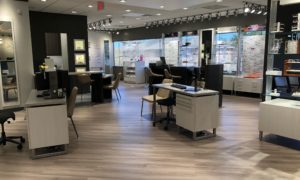 The majority of eyecare providers say sales of children’s eyewear (under age 14) and related services make up about the same percentage of total dollar sales as five years earlier, findings from Jobson Optical Research’s 2014 Selling Eyewear To Children report suggest. Fifty-eight percent report this area of their practice stayed about the same percentage of total dollars in 2014 compared to five years earlier, while 35 percent say sales in this area of the practice grew as a percentage of total dollars in 2014 compared to five years ago. Seven percent report that this practice sector decreased as a percentage of total dollars in 2014 compared to five years earlier.
The majority of eyecare providers say sales of children’s eyewear (under age 14) and related services make up about the same percentage of total dollar sales as five years earlier, findings from Jobson Optical Research’s 2014 Selling Eyewear To Children report suggest. Fifty-eight percent report this area of their practice stayed about the same percentage of total dollars in 2014 compared to five years earlier, while 35 percent say sales in this area of the practice grew as a percentage of total dollars in 2014 compared to five years ago. Seven percent report that this practice sector decreased as a percentage of total dollars in 2014 compared to five years earlier.
Undetected problems are unresolved problems. Are there populations of patients within your practice with undetected, and, therefore, unresolved problems? Conditions like glaucoma get a lot of attention. Statistically, only about a half of all people with glaucoma have been diagnosed. With new technologies, we are doing a better job of discovering and treating glaucoma, but we still have further to go.
There are other populations of patients needing our attention. Estimates are that almost 25 percent of school-age children have vision problems, with only about one-third havingeye examinations prior to attending school. This results in children with undetected vision problemsbeing limited in their educational experience. More than that, undetected vision problems can result in behavior issues that negatively impact academic and life success.
A statement in the Children’s Vision section of the AOA web site caught my attention. The statement is: “The longer a vision problem goes undiagnosed and untreated, the more a child’s brain learns to accommodate the vision problem.” These accommodations are not positive, and more than just suppression or amblyopia. The negative learned behaviors that occur when a child has binocular problems, contributing todifficulty keeping focused due to ocular-induced headaches when reading, re-reading lines and losing place when reading, can dramatically impact academic performance.
One way to interpret Jobson Optical Research’s 2014 Selling Eyewear To Children report is that the majority of ECPs have not made deeper inroads into improvingchildren’s vision over the last five years. The numbers are steady. Those numbers should be increasing. This is an area that we all should examine more closely.
Your assignment for this week is to review how you attract children to your practice.
Here are four areas for you to address:
1) Are you and your staff asking all parents to have their children’s eyes examined?
2) Is your office kid friendly?
3) Do you have a reasonable number of frames on your board for children?
All children are not the same. On the Children’s Vision section of the AOA, infant vision is defined as birth-24 months of age; preschool vision is 2-5 years of age; and school-aged vision is 6-18 years of age. Have you at least broken down your frame board into these three areas with an adequate number of frames for each grouping?
4) Do your internal and external marketing materials address children’s vision issues?
Create a plan, then work your plan. Let’s make a difference.

























